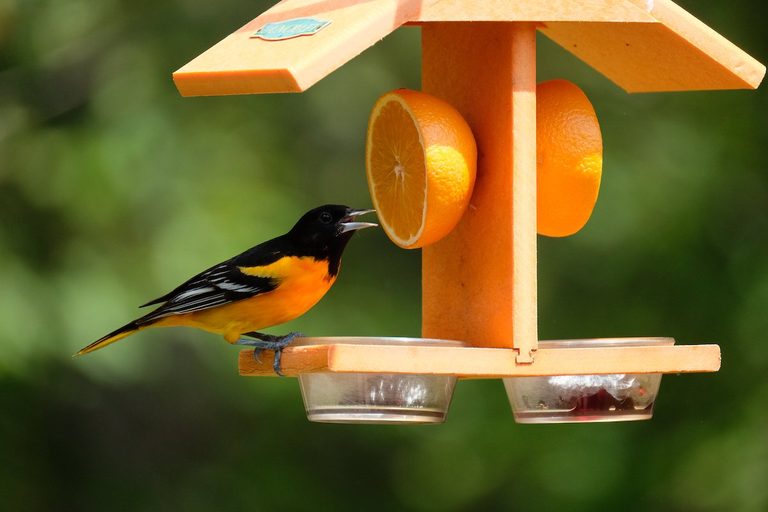
Baltimore Oriole
By Julie Jansen
The Baltimore Oriole The rich, whistling song of the Baltimore Oriole, echoing from treetops near homes and parks, is a sweet herald of spring in eastern North America. Look way up to find these singers: the male's brilliant orange plumage blazes from high branches like a torch.
American orioles are in the same family as blackbirds and meadowlarks. Baltimore Orioles got their name from their bold orange-and-black plumage: they sport the same colors as the heraldic crest of England's Baltimore family (who also gave their name to Maryland's largest city).
Baltimore Oriole forages by searching for insects among the foliage of trees and shrubs. Sometimes they fly out to catch insects in midair and especially like caterpillars, including hairy types avoided by many birds. They will visits flowers for nectar, and will come to sugar-water feeders as well as come to pieces of fruit put out on feeders. Baltimore Orioles sometimes use their slender beaks to feed in an unusual way, called "gaping": they stab the closed bill into soft fruits, and then open their mouths to cut a juicy swath from which they drink with their brushy-tipped tongues. They have 4-5, sometimes 3-6 eggs. The eggs are bluish white to pale gray, with brown and black markings concentrated at larger end. Incubation is by female, for about 12-14 days. Both parents feed the nestlings and the young leave nest about 12-14 days after hatching. A male sings to defend nesting territory. In courtship, a male will face a female and stretch upright, and then bow deeply with tail spread and wings partly open. Nest site is in tall deciduous tree, placed near the end of a slender drooping branch, usually 20-30' above the ground but can be 6-60' up or higher. Nest (built by the female, sometimes with help from the male) is a hanging pouch, with its rim firmly attached to a branch. The nest is tightly woven of plant fibers, strips of bark, grapevines, grass, yarn or string, The inside is lined with fine grass, plant down and hair. (I hope animal hair!) Some orioles will take up to 12 days to construct their pendulous sac-shaped nest. This precarious placement keeps the eggs and babies relatively safe from climbing predators and other nest robbers.
Young male Baltimore Orioles do not molt into bright-orange adult plumage until the fall of their second year. Still, a few first-year males in drab, female-like plumage succeed in attracting a mate and raising young. Females become deeper orange with every molt; some older females are almost as bright orange as males.
Orioles spend their winters in Mexico and Central and South America, where they can find a steady source of insects, fruit and nectar. Then they migrate north to nest in early spring. Your chance to see orioles doesn't last long, because most start to migrate south in August. It's a thrill to see these beautiful and sometimes elusive songbirds.